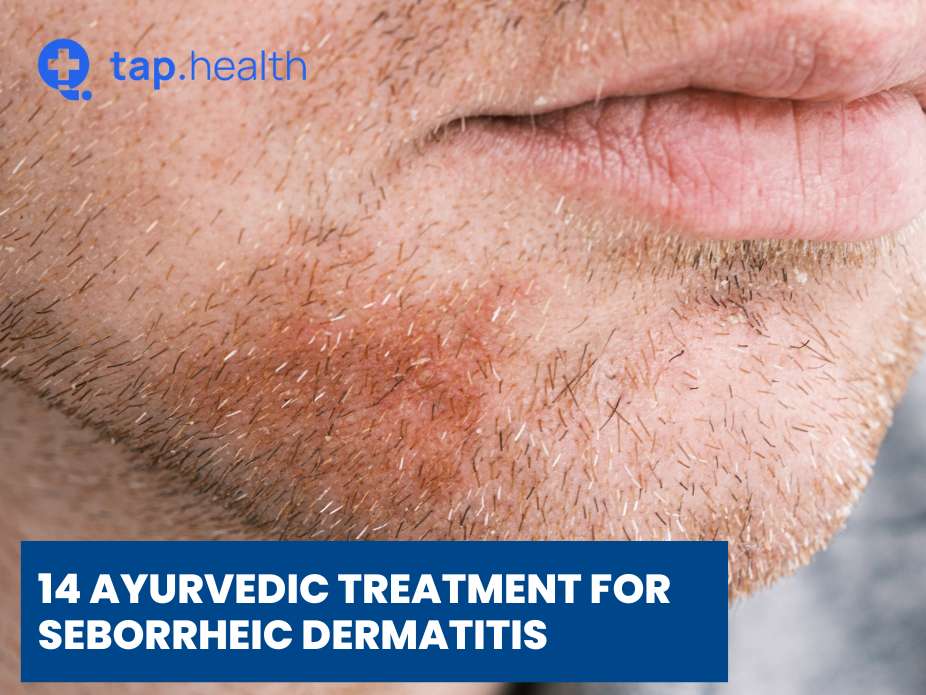Seborrheic dermatitis is a chronic skin condition causing red, scaly, and itchy patches, primarily on the scalp, face, and chest. Ayurveda, the ancient Indian healing system, offers natural remedies to address its root causes by balancing the body’s doshas—Vata, Pitta, and Kapha. This blog explores 14 effective Ayurvedic treatments, including herbal remedies, Panchakarma therapies, and lifestyle changes, to manage seborrheic dermatitis holistically.
Understanding Seborrheic Dermatitis in Ayurveda
In Ayurveda, seborrheic dermatitis, known as Darunaka, stems from an imbalance in Pitta and Kapha doshas, leading to toxin buildup (ama). Pitta’s heat causes inflammation and redness, while Kapha’s excess oiliness results in scaling. Ayurvedic treatments focus on detoxifying the body, balancing doshas, and promoting skin health through natural methods.
What Causes Seborrheic Dermatitis in Ayurveda?
The condition arises from Pitta and Kapha imbalances, often triggered by poor diet, stress, or improper lifestyle habits. These factors lead to toxin accumulation, manifesting as skin issues like redness, itching, and flaking.
Top 14 Ayurvedic Treatments for Seborrheic Dermatitis
Ayurveda employs a multi-pronged approach, combining herbal remedies, detoxification therapies, dietary adjustments, and lifestyle changes to manage seborrheic dermatitis effectively. Below are 14 proven treatments:
1. Bhringraj for Scalp Health
Bhringraj, known as the “king of herbs” for hair, is a potent remedy for scalp conditions. Its detoxifying and anti-inflammatory properties reduce itching and scaling.
- How to Use: Massage Bhringraj oil into the scalp 2–3 times weekly. Leave it on for an hour before rinsing with a mild cleanser.
2. Neem for Antimicrobial Relief
Neem’s antifungal and anti-inflammatory properties make it ideal for soothing irritated skin. It also purifies the blood, reducing toxin levels.
- How to Use: Apply neem oil or paste to affected areas daily. Alternatively, consume neem leaf capsules under professional guidance.
3. Manjistha for Blood Purification
Manjistha is a powerful herb that detoxifies the blood and reduces skin inflammation. It’s effective for chronic skin conditions like seborrheic dermatitis.
- How to Use: Take Manjistha powder or capsules as prescribed, or apply a paste mixed with honey to affected areas.
4. Aloe Vera for Soothing Hydration
Aloe vera’s cooling and moisturizing properties relieve itching and dryness, promoting skin healing.
- How to Use: Apply fresh aloe vera gel to affected areas daily. Leave it on for 20–30 minutes before rinsing.
5. Marichyadi Thailam for Anti-Inflammatory Benefits
This traditional Ayurvedic oil, containing black pepper and sesame oil, has antifungal and anti-inflammatory properties.
- How to Use: Gently massage warm Marichyadi Thailam into the scalp or affected areas 2–3 times weekly.
6. Mustard Oil for Kapha Balance
Mustard oil’s warming properties help balance Kapha, reducing oiliness and flakiness on the scalp.
- How to Use: Apply warm mustard oil to the scalp, massage gently, and rinse after 30 minutes.
7. Nasya for Head and Neck Detox
Nasya, the nasal administration of herbal oils, clears toxins from the head and neck, alleviating scalp irritation and dandruff.
- How to Use: Administer under the guidance of an Ayurvedic practitioner, typically using medicated oils like Anu Taila.
8. Vamana for Kapha Elimination
Vamana, a Panchakarma therapy, involves induced vomiting to remove excess Kapha, reducing oiliness and scaling.
- How to Use: Performed by a trained practitioner, Vamana is recommended for severe cases.
9. Virechana for Pitta Detox
Virechana, a purgation therapy, eliminates excess Pitta, reducing inflammation and detoxifying the liver.
- How to Use: Administered under professional supervision, typically after preparatory therapies.
10. Basti for Vata Balance
Basti, an enema therapy using medicated oils, cleanses the colon and balances Vata, supporting overall health.
- How to Use: Conducted by an Ayurvedic expert as part of Panchakarma.
11. Raktamokshana for Blood Purification
This bloodletting therapy removes toxins from the blood, beneficial for severe inflammation in seborrheic dermatitis.
- How to Use: Performed by a qualified practitioner in specific cases.
12. Dietary Adjustments for Dosha Balance
A balanced diet is crucial in Ayurveda to manage seborrheic dermatitis.
- Tips:
- Include fresh fruits, vegetables, and whole grains like quinoa and barley.
- Avoid spicy, oily, and processed foods that aggravate Pitta.
- Use healthy fats like ghee or coconut oil for skin nourishment.
13. Hydration for Toxin Flush
Drinking ample water keeps the skin hydrated and supports toxin elimination.
- Tips: Aim for 8–10 glasses of water daily, and include herbal teas like cumin-coriander-fennel (CCF) tea.
14. Lifestyle Changes for Holistic Healing
A healthy lifestyle complements Ayurvedic treatments.
- Tips:
- Practice yoga and Pranayama to improve circulation and reduce stress.
- Get 7–8 hours of sleep for skin regeneration.
- Use mild, natural cleansers to maintain hygiene without irritating the skin.
How Long Does It Take to See Results with Ayurvedic Treatments?
Results vary based on the condition’s severity and individual response. Some may see improvements within 2–4 weeks, while others may need 2–3 months of consistent treatment. Combining herbal remedies, Panchakarma, and lifestyle changes yields faster results.
Are Ayurvedic Treatments Safe for Seborrheic Dermatitis?
Ayurvedic treatments are generally safe when guided by a qualified practitioner. Always follow recommended dosages and consult an expert to avoid side effects, especially with Panchakarma or internal herbs.
Can Diet and Lifestyle Alone Manage Seborrheic Dermatitis?
Diet and lifestyle changes significantly reduce symptoms by addressing dosha imbalances. However, combining them with herbal remedies and therapies like Panchakarma provides more comprehensive relief.
Is Ayurveda Suitable for All Ages?
Yes, Ayurveda can be customized for all age groups. Consult an Ayurvedic practitioner to tailor treatments based on age, health, and specific needs.
Can Ayurvedic Treatments Cure Seborrheic Dermatitis?
Ayurveda focuses on managing symptoms and addressing root causes rather than promising a complete cure. Many individuals experience significant relief with consistent treatment, but outcomes depend on individual factors like severity and adherence.
Additional Tips for Managing Seborrheic Dermatitis Naturally
- Stress Management: Practice meditation or mindfulness to reduce stress, which can exacerbate symptoms.
- Avoid Harsh Products: Use natural, chemical-free shampoos and soaps to prevent irritation.
- Regular Monitoring: Work with an Ayurvedic practitioner to adjust treatments as needed.
Conclusion
Ayurveda offers a holistic approach to managing seborrheic dermatitis through herbal remedies, Panchakarma therapies, and lifestyle modifications. By addressing Pitta and Kapha imbalances and eliminating toxins, these 14 treatments promote healthier skin and overall well-being. Always consult a qualified Ayurvedic practitioner to personalize your treatment plan and achieve optimal results.



